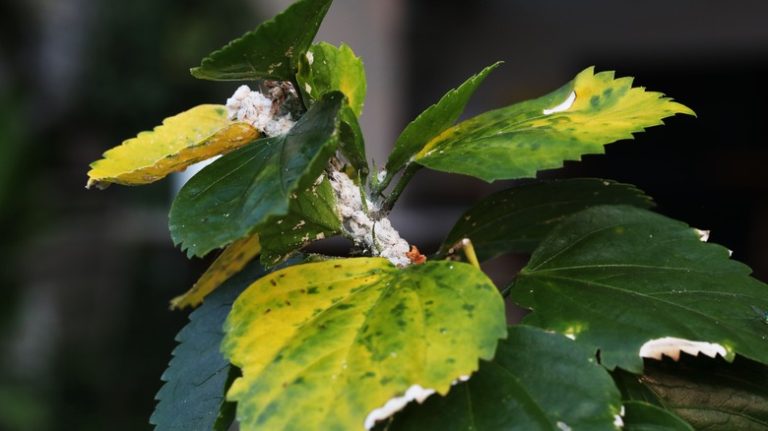The lilac (scientific name: syringa) is a flowering shrub that blooms every year in the spring, as per Garden Design. It is loved around the world for the fragrant scent of its blooms, which attracts butterflies, and its small, delicate flowers. The flower color differs from species to species and includes white, purple, pink, and blue. While you can find this plant in a variety of sizes, they reach, on average, between 12 and 15 feet in height, making them the perfect hedge bush for your outdoor space. This shrub is also marked by its vibrant foliage, which stays green year-round.
The history of the lilac shrub dates back to ancient Greece and forms part of Greek mythology, according to Better Homes & Gardens. One such myth tells the story of the god of the forests, Pan, who stalked a nymph named Syringa in the pursuit of her affections. Syringa wasn’t interested in Pan and decided to become a lilac shrub to hide from him. Ironically, Pan came across the shrub, not knowing it was the nymph he loved, and used some of its parts to manufacture the musical instrument known as a panpipe, or pan flute.
You’ll likely be glad to discover that lilacs are relatively easy to grow and care for and can even live up to 100 years when provided with their preferred growing conditions. Keep scrolling for an in-depth guide on how to plant and sustain this beautiful shrub.
How to use lilacs in garden
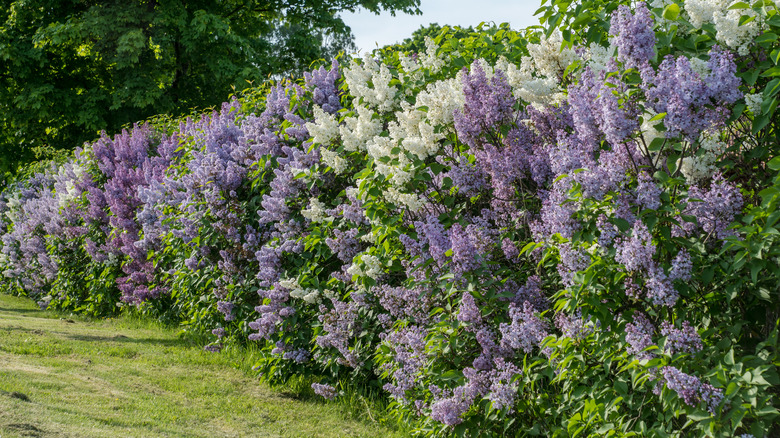
As lilacs grow in bushes, it’s best to plant them in areas of your garden that will serve as borders. For example, planting them along a fence or the side of your house provides privacy while also adding a colorful boundary to different areas of your yard. Since this flower is also known for its delicious fragrance, planting them where you are likely to pass frequently, such as near an entryway to your home or lining a pathway, will allow you to enjoy their scent every time you walk by. Additionally, it may also be a good idea to choose a specific variety of lilac for your garden based on its size. A more compact species can be placed on its own in a corner of your yard while larger varieties can serve as a focal point in the center.
SF Gate suggests that gardeners grow lilacs in the same vicinity as other flowering shrubs, especially ones that have different bloom times. This will maximize the amount of time you get to see your garden in full bloom during the growing season while also adding a bit of texture to the scene. Some of the best companion plants for lilacs include flowering dogwoods, magnolias, flowering cherries, peonies, and conifers, according to Gardenia. Get creative with the bloom color of the plants you surround your lilacs with to produce a truly spectacular sight in your own landscaped backyard.
How to grow lilacs
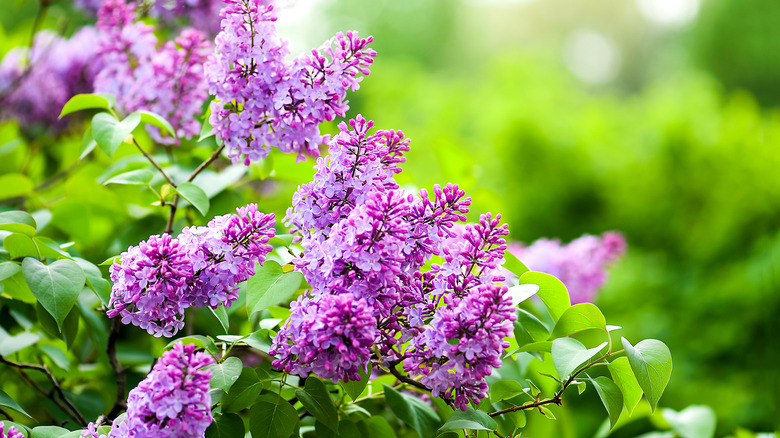
Lilacs are typically planted in the fall from a sucker (also known as an offshoot) or a transplant bought directly from a plant nursery. The former is essentially a weed-like shoot that sprouts up from the base of the plant and is connected to the root system, per Flower Patch Farmhouse. You will need to dig up the shoot in order to plant it in another location, taking care to catch the roots embedded within the earth as you do so. The more shoots you collect, the better the chances that one will survive once planted and grow into a full lilac bush. Once you’ve dug up a few, place them in a container of water. Next, you’ll need to dig a hole deep enough to plant the sucker so it stands up straight. Fill it in with soil and keep it well-watered until it gets established. Keep in mind that suckers take a few years to become full-grown bushes.
A transplanted lilac shrub is one that is grown in a container and is typically well established when you purchase it from a nursery, according to Almanac. You can also find transplants with their root systems wrapped in burlap. It’s very simple to plant this type of lilac in your garden. You should first dig a hole deep enough to accommodate the entire root ball and then cover it completely with soil. The area around the roots should be well packed with soil.
How to care for lilacs
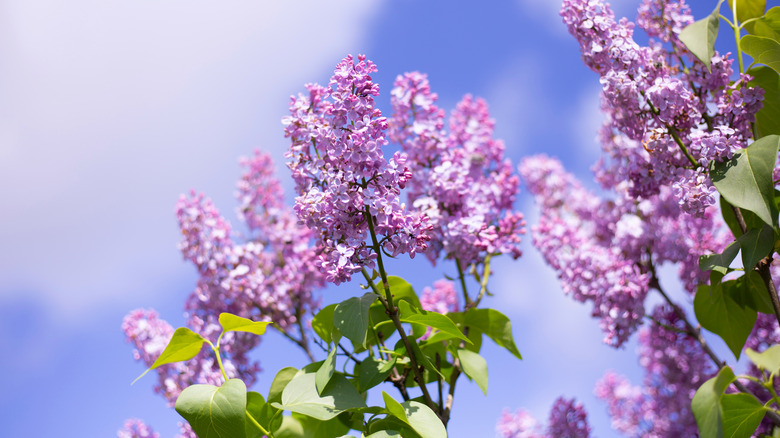
Mykola Lysenko/Shutterstock
Once planted, lilacs won’t require much intervention on your end as long as the growing conditions meet their needs. Lilacs require plenty of sun and should be planted in an area of your garden that receives direct sun during the spring growing season, as noted by The Spruce. This equates to a minimum of six hours a day of full sunlight. When it comes to watering needs, the less water you give, the better. In fact, lilacs won’t thrive in regions that receive too much rain or humidity. Note that the water needs of young versus old shrubs will differ. Immature plants need regular watering while already established shrubs should only be given water in the absence of rain every couple of weeks. Overwatering renders your lilacs susceptible to fungal diseases that can cause root rot.
Given that lilacs have a minimal tolerance for wet soil, make sure that your garden soil is a well-draining variety with a neutral pH level for optimal growth. In the spring, you can sprinkle some mulch and fertilizer around the base of your lilac bushes to encourage healthy blooms. One other critical component of lilac care is to prune the bushes once the blooming season has ended and the flowers start to die off. Prune any weakened branches to facilitate air circulation and cut down on overgrowth. Take care not to prune too much of your lilac shrubs or you will see a decrease in blooms the following season.
Varieties of lilacs
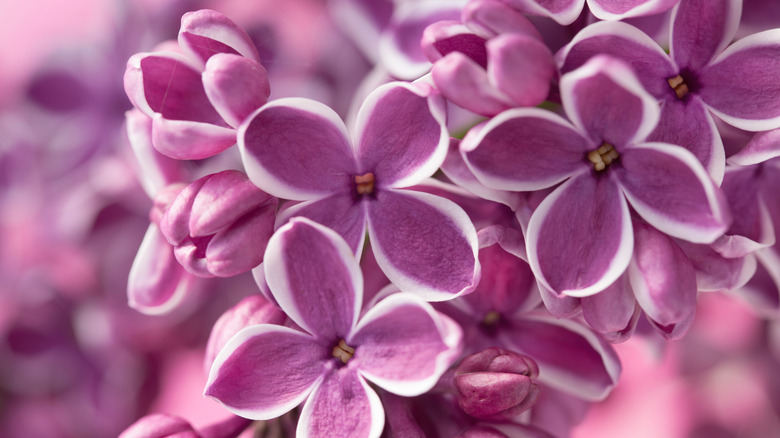
Shulevskyy Volodymyr/Shutterstock
Lilacs (scientific name: syringa) hail from southeastern Europe and are a relative of the olive family, as per Britannica. Depending on the variety of lilac, this plant can grow up to 30 feet and resemble a small tree. There are over 1,000 varieties of lilac in existence today that come in a range of sizes and colors. Many have been crossed with other varieties within the family and are engineered hybrids. As such, some varieties are better to grow in your yard than others, depending on your needs and the size of your outdoor space.
Within the common lilac variety (scientific name: syringa vulgaris), you have Little Boy Blue, which produces blooms in a light-blue hue and is a smaller variety of lilac; it’s perfect for the nooks and crannies of your garden, according to the Chicago Botanic Garden. Another dwarf shrub, Miss Kim, is a part of the Manchurian lilac variety (scientific name: syringa patula). It can grow as tall as 6 feet but is more likely to hover around 4 feet in height. The Japanese tree lilac (scientific name: syringa reticulata) is a popular variety of lilac that can grow up to 30 feet in height and features dark-red bark and tiny, white flowers. The Meyer lilac (scientific name: syringa meyeri) is a great option for more humid environments as it is resistant to mildew. You may also enjoy its abundant violet blooms.
Are lilacs toxic?
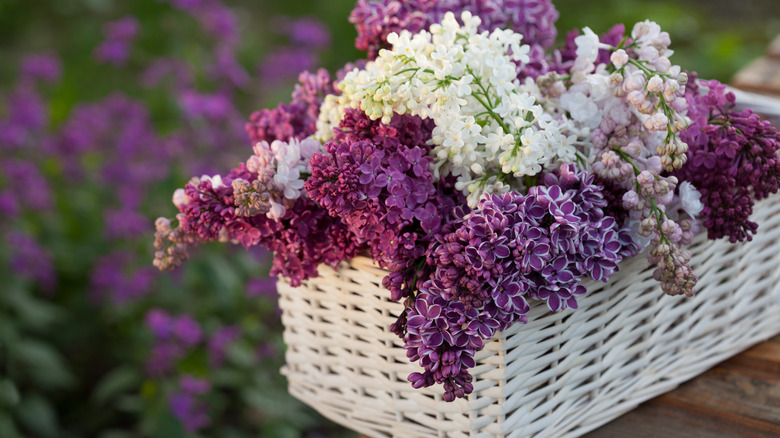
Shulevskyy Volodymyr/Shutterstock
You may be pleased to learn that no part of the lilac plant is toxic to humans, as per Plant Addicts. This means it won’t cause digestive distress when ingested or skin irritation when touched. You can even incorporate the lilac bloom into your favorite recipes. Homespun Seasonal Living recommends baking lilac flowers into sweet treats or sprinkling them on salads for a savory palette. Lilacs are also a popular addition to teas and homemade wines. If you’re feeling extra creative, decorate the top of a cake with lilacs for visual texture. However, you may have to assure any guests that the lilacs are safe to eat!
While lilacs are safe for human consumption, you may need to take extra care if you have pets, as the plant has been found to cause some level of digestive discomfort in animals, reports Plant Addicts. This depends entirely on the tolerance of the individual animal as lilacs do not present any toxic chemicals that can contribute to this discomfort. The one exception to this is the Persian lilac, which is poisonous to cats. It may be best to prevent pets from having access to your lilac bushes if they typically like to chew on plants. Creating a barrier around each shrub is always a good idea to keep your pets away. As this might not be an option for every garden, it is also possible to discourage pets from approaching your lilacs through the use of a bitter spray.
How to repot lilacs
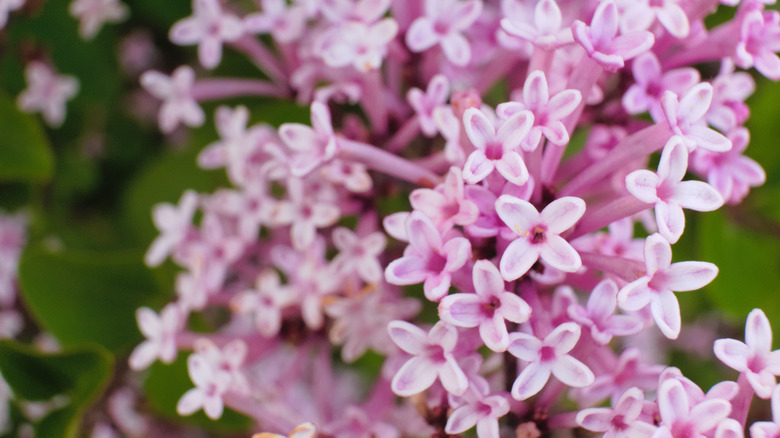
CarlosR/Shutterstock
Due to their large size, lilacs aren’t typically grown in pots or containers. However, smaller varieties can be planted in containers, especially if you don’t have the option of a yard to plant them in the ground. Potted lilacs are perfect for decks, patios, and balconies, allowing you to enjoy their colorful blooms and fragrant scent every spring. Gardening Know How recommends choosing any variety of dwarf lilac to ensure the shrub won’t eventually need more space to spread its roots and purchasing a container that is at least 1 foot deep and 2 feet wide. Some varieties may require an even larger container once they are fully mature. You will be able to tell if your lilac needs an upgrade if the root system begins growing out of the drainage holes and bunching at the bottom or if the plant starts to die.
Make sure you purchase a potting soil that is well draining and has a neutral pH. Once you have your materials, spread a layer of soil at the base of the container and place the root ball on top. Fill in the area around the roots with soil to ensure the entire root system is completely buried. Just like with garden-planted lilacs, your potted lilacs will need a minimum of six hours of direct sun a day. However, unlike their garden counterparts, container-bound lilacs need more water. You can add more whenever the top soil dries out completely.
Lilac diseases to look out for
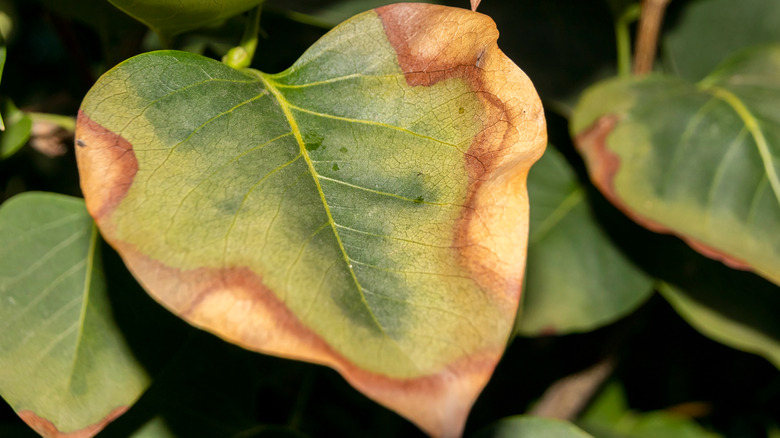
photowind/Shutterstock
There are three main diseases that can infect your lilac bushes, including powdery mildew, bacterial blight, and leaf spots, as per Gardening Know How. The first, powdery mildew, is caused by a fungus and presents as white spots on the leaves of the plant. While powdery mildew won’t kill your lilacs, it is best to keep it at bay as much as possible. The main way to do this is by making sure the shrub has enough air circulation, which can be achieved by pruning it regularly. If you would like to use a fungicide to treat powdery mildew, note that you must spray the plant as soon as you notice the white areas, according to the University of New Hampshire.
The second disease, bacterial blight, mostly affects the leaves of the lilac plant; you may notice that the leaves start to change color around the edges. The blooms often show signs of the disease and begin to wilt before dying. To treat bacterial blight, start by cutting off and disposing of any infected parts of the plant. You can then spray a copper fungicide to get rid of any remaining bacteria. The final disease, leaf spots, is caused by a fungus that is attracted to plants that are overwatered or surrounded by too much humidity. Brown stains will appear on the leaves of your lilacs, which should be immediately removed. Pruning is the best preventative measure to take.




